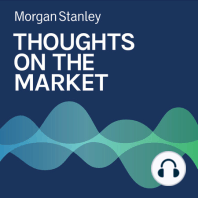3 min listen

Chetan Ahya: Has Inflation in Asia Peaked?
Chetan Ahya: Has Inflation in Asia Peaked?
ratings:
Length:
4 minutes
Released:
Jan 5, 2023
Format:
Podcast episode
Description
With the fight against inflation quieting down in many regions, Asia saw a relatively small step up in inflation. Will that leave 2023 open to the possibility of growth outperformance?----- Transcript -----Welcome to Thoughts on the Market. I'm Chetan Ahya, Morgan Stanley's Chief Asia Economist. Along with my colleagues, bringing you a variety of perspectives, today I'll be discussing our 2023 outlook for Asia economics. It's Thursday, January 5th at 9 a.m. in Hong Kong. If 2022 was all about inflation, we believe 2023 will be about the aftermath of this battle with inflation. All eyes are now on how the world's largest economies will stack up after this battle with inflation. While Asia, along with the rest of the world, face multiple stagflationary shocks in 2022, we think that Asia weathered these shocks better. Indeed, we believe Asia will enter a rapid phase of disinflation and is well-positioned for growth outperformance in 2023. The step up in Asia's inflation was smaller compared to other regions. Furthermore, Asia's inflation had more of a cost-push element, meaning it was driven to a large extent by increases in cost of raw materials. And we believe Asia's inflation already peaked in third quarter of 2022. Asia's inflation should be rapidly returning towards central bank's comfort zone. We expect this to be the case for 90% of Asian economies by mid 2023. Cost-push factors are fading, resulting in lower food and energy inflation. Core good prices are descending rapidly, given the deflation in goods demand. Moreover, labor markets were not that tight in Asia, and wage growth has remained below its pre-COVID rates. Because of this backdrop, we've argued that central banks in Asia do not need to take policy rates deeper into restrictive territory. In fact, all of the central banks in the region will likely stop tightening in first quarter of 2023. This pause in Asia's rate hiking cycle, coupled with an easing in U.S. 10 year bond yields and with the peak of USD behind us, should lead to easier financial conditions in 2023. While weak external demand will remain a drag at least through the first half of 2023, Asia's domestic demand is supported by three factors. First, the easing of financial conditions will lift the private sector sentiment. Second, we are witnessing a strong uplift in large economies like India and Indonesia, supported by healthy balance sheets. Finally, China's reopening will lift consumption growth and have a positive effect on economies in the region, principally via the trade channel, helping Asian economies to get onto the path of growth outperformance. We expect Asia's growth to improve from a trough of 2.8% in first quarter of 2023, to 4.9% in second half of 2023, while DM growth will slow from 0.9% in first quarter of 2023 to 0.3% in second half of 23. Growth differentials will likely swing back in Asia's favor, rising back towards the levels last seen in 2017 and 2018. There are, of course, risks to our optimistic outlook for Asia. If U.S. inflation stays elevated for longer, this would lead to more tightening by the Fed than is expected and could drive renewed strength in the USD. This in turn would prolong the rate hike cycle in Asia, keeping financial conditions tight and exert downward pressures on growth. A delayed reopening in China could impact China's growth trajectory with adverse spillover implications for the rest of the region. Thanks for listening. If you enjoyed the show, please leave us a review on Apple Podcasts and share Thoughts on the Market with a friend or a colleague today.
Released:
Jan 5, 2023
Format:
Podcast episode
Titles in the series (100)
Michael Zezas: Three Possible Trade Paths from the G20 by Thoughts on the Market